Lose Weight With This Four-Week Meal Plan For Men
Lose weight the healthy way with this dietitian-approved 1,800-calorie-a-day diet

Congratulations – you have found the best four-week weight-loss meal plan for men on the internet! No need to thank us, especially since we didn’t do the hard work putting it together. Thank award-winning dietitian Azmina Govindji, who has not only chosen delicious meals for breakfast, lunch and dinner, plus snacks, she’s also kept to a daily 1,800-calorie limit.
Impressive stuff, but not as impressive as doing all that while also making sure that, on average, this meal plan meets the main dietary recommendations. So that’s recommended daily allowances of fat, saturates, fibre and salt, as well as recommended daily requirements of most minerals and vitamins. And of course, you’ll (finally) be eating at least five portions of fruit and veg a day.
Govindji has also kept the calorie content of your breakfast, lunch and dinner in a similar ratio to Public Health England’s 400-600-600 calorie guidelines, so you’ll become accustomed to that pattern of eating and will find it easier to continue in the same vein after the four-week period is up.
If this all sounds too good to be true, let us reassure you that you can trust this meal plan because Govindji is a dietitian. As we’ve explained elsewhere, that’s a protected term and means Govindji is governed by an ethical code and her work is regulated by law. Govindji has also worked for the NHS, was chief dietitian at Diabetes UK and has worked with BAME communities on behalf of Public Health England.
So will you lose weight if you follow it? We’re confident you will, and thanks to the extra fibre you’ll be eating, the likelihood is you won’t feel ravenous for 28 long days either.
Four-Week Weight-Loss Meal Plan For Men
This meal plan allows for 100ml of semi-skimmed or 1% fat milk a day to drink or use in tea and coffee (see below), as well as a daily allowance of 2tsp (10g) of reduced-fat spread to use for bread rolls, toast, sandwiches, baked potatoes or to melt over vegetables.
Drinks-wise, you can glug down unlimited water (of course), sugar-free soft drinks, tea and coffee. If you take your hot beverage with milk, note that you should draw from your milk allowance above.
Get the Coach Newsletter
Sign up for workout ideas, training advice, reviews of the latest gear and more.
The plan also allows for up to five other drinks per week, as follows:
Milk-based coffees should be skinny latte or similar, about 100 calories. Alternatively, alcoholic drinks providing about one unit of alcohol can be included (a maximum of five units over the week); for example a small (125ml) glass of wine, a half pint of 4% alcohol lager or cider, or a single measure of spirits with no added sugary mixer.
If you’re vegetarian or vegan, fortified plant-based drinks such as soya, oat or almond milk alternative can be substituted for semi-skimmed milk. Check the label and make sure it has added calcium, iodine, vitamin D and vitamin B12.
Vegetarian or vegan alternatives to meat and cheese can also be substituted. For example, try tofu, Quorn or soya mince, and vegan alternatives to cheese (although note that cheese substitutes will not give you the nutrients found in dairy).
If you need a break from cooking occasionally, it’s fine to swap in a ready meal from a healthier eating range or a healthier takeaway option. Choose “lighter” dishes if these are available, or if nutritional information is provided, aim for about 500 calories. Avoid deep-fried dishes and creamy curries. Good options include wraps filled with extra salad, standard burgers without mayo and cheese, and “lighter” pizzas with lots of vegetable toppings and less cheese.
- Feel free to swap breakfast, lunch and dinner options between days to suit. Make sure you choose a swap with a similar calorie content.
- Snack suggestions, particularly fruit and yogurt, can be incorporated into one of the meals if you prefer.
Pack sizes vary by retail outlet, but this plan and the nutritional information is based on a salmon fillet of 100g cooked weight, chicken breast of 120g cooked weight, 120g pot of yogurt, 200g cans of beans and tomatoes, and drained weights of 60g (small) or 120g (medium) for canned tuna. For ease of use, the recipe suggestions include dry weights of grains like rice and pasta.
We’ve included some cooking directions, but if you’re unsure, search the internet for similar recipes and the general method will become clear.
Week One: Monday
Breakfast: Vegan overnight oats (355 calories)
- 40g oats
- 150ml plant-based drink (eg almond drink)
- 1tbsp chia seeds
- 80g raspberries (or frozen mixed berries)
- 1tbsp almond butter
Combine the ingredients in a bowl before you go to bed and leave overnight in the fridge to set.
Lunch: Wholemeal bagel with chicken tikka and salad (525 calories)
- 120g chicken tikka
- Tomato and red onion slices
- Handful of baby spinach
- 1tsp reduced-fat mayonnaise
Dinner: Salmon and vegetable pasta (620 calories)
- 1 cooked salmon fillet
- 75g wholewheat pasta (dry weight)
- 2tbsp peas
- 60g broccoli
- 60g green beans
- 1tbsp medium-fat soft cheese
- 1tbsp milk
- Chilli and chives to taste
This dinner supplies half your daily fibre target, about 40% of your recommended selenium and zinc needs, and over 70% of your recommended vitamin D intake. Oily fish like salmon contain omega-3 fatty acids – we should all be eating a portion a week.
Snacks: 1 digestive biscuit. Small (80g) bowl of melon, pineapple and mango pieces. 100 calories
Week One: Tuesday
Breakfast: Avocado and egg on toast (345 calories)
- ½ avocado
- 1 egg, poached
- 1 thick slice of seeded toast
Lunch: Tomato soup, and toasted cheese and mushroom sandwich (490 calories)
- ½ carton chilled or canned shop-bought tomato soup
- 2 thick slices wholemeal bread
- 2tbsp grated mozzarella
- 2 sliced mushrooms
Dinner: Chicken fajitas (525 calories)
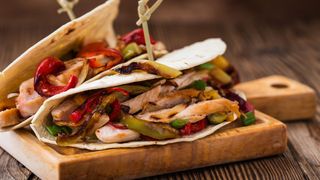
- 1 chicken breast
- ½ pepper
- 1 small onion
- 2tsp oil for frying
- fajita seasoning to taste
- 2 medium wholemeal tortilla wraps
- 1tbsp shop-bought salsa
Snacks: Strawberry and banana smoothie made with low-fat yogurt and milk (150ml). Small cereal bar. 190 calories
Week One: Wednesday
Breakfast: Cereal (310 calories)
- 2 wheat biscuits
- 100ml semi-skimmed milk
- 4 dried apricots
- 1tbsp flaked almonds
This breakfast provides over 70% of your daily iron needs.
Lunch: Ham or turkey salad sandwich (470 calories)
- 2 thick slices of seeded bread
- 1 slice of ham or turkey
- 1tsp mustard
- 1 tomato and a handful of salad leaves
- Small bag (25g) of baked crisps
- Apple
Dinner: Tomato and spinach dhal (525 calories)
- 50g red lentils
- Small can of chopped tomatoes
- Handful of baby spinach
- 1 small onion
- 2tsp oil
- Garlic
- Ginger
- Spices
- Plain chapati
This powerful dish provides your daily iron in one meal and pairs it with lots of vitamin C which helps absorption of iron from vegetarian foods.
Snacks: Handful of cashew nuts. Pear. 250 calories
Week One: Thursday
Breakfast: Peanut butter and banana bagel (400 calories)
- 1tbsp peanut butter
- 1 wholemeal bagel
- Small banana, sliced
Lunch: Tuna and sweetcorn baked potato (485 calories)
- 1 large baked potato
- 1 medium can of tuna
- 1 heaped tbsp reduced-fat mayonnaise
- 2tbsp sweetcorn
- Mixed salad
You’ve just ticked off all of your recommended selenium intake in one meal. Give yourself a pat on the back.
Dinner: Turkey meatballs (495 calories)
- 4 turkey meatballs
- 125g homemade or bought tomato sauce
- Wholemeal spaghetti (75g dry weight)
- Green salad
This meal has over half of your daily recommended intake of zinc.
Snacks: Small pot of low-fat fruit yogurt. 1tbsp sunflower seeds. 190 calories
Week One: Friday
Breakfast: Green smoothie (330 calories)
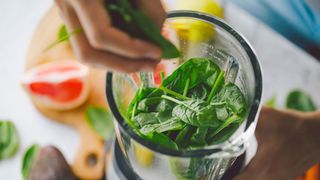
- Large handful of kale or spinach
- 1 small banana
- 2tbsp oats
- 150ml (or to taste) plant-based drink (eg almond)
- 1tbsp almond butter
Lunch: Egg mayonnaise bap (475 calories)
- 1 large egg
- 1tbsp reduced-fat mayonnaise
- Handful of baby spinach
- 1 large wholemeal bap
- Cherry tomatoes
- Cucumber sticks
- Small pot of low-fat fruit yogurt (for dessert)
The egg and yogurt both contain iodine, providing almost three-quarters of the recommended intake. Eggs are one of the few sources of vitamin D in the diet and this meal provides 20% of the recommended intake.
Dinner: Spicy cod and vegetable parcel (500 calories)
- 1 cod fillet
- 1 carrot
- ½ pepper
- A few mangetout, cut into thin strips
- 1tsp reduced-salt soy sauce
- 1tsp sesame oil
- Ginger, chopped
- Chilli, sliced
- 60g wholegrain rice (dry weight)
- Scoop of frozen yogurt (for dessert)
Bake the cod in a foil parcel with the other ingredients, cutting the vegetables into thin strips.
Snacks: Slice of toasted seeded bread with yeast extract. Handful of peanuts and raisins. 275 calories
Week One: Saturday
Breakfast: Scrambled egg on toast with sautéed mushrooms (365 calories)
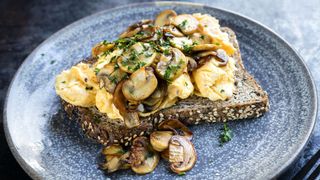
- 1 egg
- 1 thick slice wholemeal toast
- 100g mushrooms
- 1tsp oil
Lunch: Roasted veg wrap (510 calories)
- 1 large wholemeal wrap
- 2tbsp reduced-fat hummus
- 100g roasted vegetables
- Handful of rocket
- Handful of mixed nuts and raisins
Dinner: Takeaway or ready meal
Take a break from cooking and choose a healthier takeaway option like a grilled chicken burger, wrap or “lighter” pizza, or have a ready meal from a healthier-eating range. Aim for about 500 calories.
Snacks: 2tbsp low-fat plain yogurt with 80g mixed fresh fruit. Small bag (14g) of lightly salted popcorn. 160 calories
Week One: Sunday
Breakfast: Cereal (325 calories)
- 3 handfuls no-added-sugar muesli
- 100ml semi-skimmed milk
- Banana
Lunch: French-bread pizza (495 calories)
- 15cm-long piece of baguette
- 2tbsp passata
- ½ pepper, chopped
- 2 sliced mushrooms
- 1tbsp sweetcorn
- 3tbsp reduced-fat grated cheese
- Mixed salad
Slice the baguette lengthways, spread on the passata, add the toppings and cheese, and grill. Serve with crisp salad.
Dinner: Steak (520 calories)
- 1 lean beef fillet steak, grilled
- 1 large baked potato
- 80g baby sweetcorn
- 80g mangetout
Snacks: 1tbsp reduced-fat hummus and 2 celery sticks. Handful of grapes. 1 chocolate digestive biscuit. 210 calories
Week Two: Monday
Breakfast: Beans on toast (360 calories)
- Small can or pot of baked beans
- 1 thick slice of seeded toast
- 150ml glass of orange or other pure fruit juice
Lunch: Chicken and avocado wrap (505 calories)
- 1 large wholemeal wrap
- 1 cooked chicken breast
- ½ avocado
- ½ pepper
Dinner: Vegetarian spaghetti bolognese (545 calories)
- 125g Quorn (or other plant-based) mince
- Small can of chopped tomatoes
- 1 small onion
- 6 mushrooms
- 1tbsp oil
- Garlic, to taste
- Mixed herbs
- 75g wholewheat spaghetti (dry weight)
Snacks: 1 small pot of low-fat fruit yogurt. 1 apple. 150 calories
Week Two: Tuesday
Breakfast: Cereal (315 calories)
- 3 handfuls of multigrain flakes (eg Special K)
- 100ml semi-skimmed milk
- 4 dried prunes
- 1tbsp mixed nuts
Lunch: Tomato soup, and toasted cheese and mushroom sandwich (490 calories)
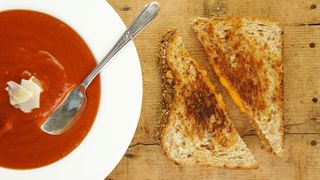
- ½ carton chilled or canned shop-bought tomato soup
- 2 thick slices wholemeal bread
- 2tbsp grated mozzarella
- 2 sliced mushrooms
Dinner: Pan-fried mackerel and new potatoes (525 calories)
- 1 mackerel fillet
- 1tsp oil, for frying
- 175g crushed new potatoes
- 80g green beans
- 80g tenderstem broccoli
- Small pot of low-fat fruit yogurt (for dessert)
We should be eating one portion a week of oily fish like mackerel, which contains omega-3 fatty acids. This meal also provides over 60% of your daily vitamin D needs.
Snacks: Two-finger chocolate-covered wafer. Handful of grapes. 175 calories
Week Two: Wednesday
Breakfast: Salmon and cream cheese bagel (325 calories)
- 1 wholemeal bagel
- 1tbsp medium-fat soft cheese
- 30g smoked salmon
- 6 cherry tomatoes
Lunch: Egg mayonnaise bap (475 calories)
- 1 large egg
- 1tbsp reduced-fat mayonnaise
- Handful of baby spinach
- 1 large wholemeal bap
- Cherry tomatoes
- Cucumber sticks
- Small pot of low fat-fruit yogurt
The egg and yogurt both contain iodine, and this lunch provides almost three-quarters of the recommended daily intake. Eggs are also one of the few dietary sources of vitamin D and this meal provides 20% of the recommended intake.
Dinner: Turkey chilli con carne (550 calories)

- 125g turkey mince
- Small can of chopped tomatoes
- 2tbsp canned red kidney beans
- 1 small onion
- 1tsp oil, for frying
- Garlic, to taste
- Chilli powder
- 60g wholegrain rice (dry weight)
Snacks: 1 orange. Handful of peanuts. 240 calories
Week Two: Thursday
Breakfast: Scrambled eggs, mushrooms and toast (345 calories)
- 1 egg
- 1 thick slice of wholemeal toast
- 100g mushrooms sautéed in 1tsp oil
Lunch: Tomato and mozzarella salad (520 calories)
- 2 tomatoes
- 1 small red onion
- Basil
- 60g reduced-fat mozzarella
- 1tbsp balsamic vinegar
- 1tbsp olive oil
- 1 ciabatta roll
Dinner: Spicy mixed bean wrap (505 calories)
- 1 large wholemeal wrap
- 1 small onion
- ½ can mixed beans
- 1tbsp tomato puree
- Fajita seasoning to taste
- 1tsp oil, for frying
- Handful of mixed leaves
- 1tbsp grated reduced-fat cheese
Round off the meal with an apple and 1tsp peanut butter.
Snacks: 7 strawberries and 1tbsp 0% fat Greek yogurt. 1tbsp pumpkin seeds. 150 calories
Week Two: Friday
Breakfast: Cereal (335 calories)
- 2 shredded wheat
- 100ml semi-skimmed milk
- ½ nectarine
- Approx 10 raspberries
- 1tbsp sunflower seeds
Lunch: Minestrone (520 calories)
- ½ carton chilled or canned shop-bought minestrone soup
- 1 ciabatta roll
- 1 apple
- 1 small cereal bar
Dinner: Jerk-style chicken (545 calories)
- 1 chicken breast
- 1tsp oil
- 1tsp honey
- 1tsp jerk seasoning
- 2 handfuls skin-on potato wedges
- 1 corn on the cob
Mix the honey, oil and jerk seasoning, then brush on the chicken breast and cook under the grill.
Snacks: 2 dried apricots and 5 almonds. Carrot and cucumber sticks. 125 calories
Week Two: Saturday
Breakfast: Avocado and egg on toast (345 calories)
- ½ avocado
- 1 egg, poached
- 1 thick slice of seeded toast
Avocados contain healthier unsaturated fats – this breakfast contains more than 40% of the recommended intake of monounsaturated fat.
Lunch: Falafel-filled pitta (500 calories)
- 2 wholemeal pitta breads
- 4 falafels
- Shredded lettuce
- Grated carrot
- Drizzle of sweet chilli sauce
This healthy lunch provides more than half of your recommended fibre intake and nearly two-thirds of your daily iron recommendation.
Dinner: Tuna pasta bake (565 calories)
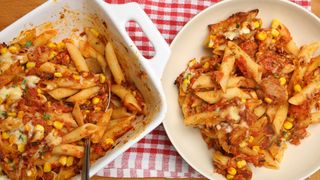
- 1 medium can of tuna
- 125g shop-bought tomato sauce
- 6 mushrooms
- 1tbsp sweetcorn
- 75g wholewheat pasta (dry weight)
- 1tbsp grated reduced-fat cheddar
Serve with a green salad.
Tuna is high in selenium and this meal provides all of your recommended selenium intake, as well as more than half of your recommended fibre intake.
Snacks: 2tbsp low-fat plain yogurt with 80g mixed fresh fruit. 1 digestive biscuit. 155 calories
Week Two: Sunday
Breakfast: Overnight oats (360 calories)
- 40g oats
- 100ml semi-skimmed milk
- 2tbsp low-fat yogurt
- 1tbsp dried fruit (or a handful of chopped fresh fruit)
- 1tsp chopped walnuts (or other nuts)
Lunch: French-bread pizza (495 calories)
- 15cm-long piece of baguette
- 2tbsp passata
- ½ pepper, chopped
- 2 sliced mushrooms
- 1tbsp sweetcorn
- 3tbsp reduced-fat grated cheese
- Mixed salad
Slice the baguette lengthways, spread on the passata, add the toppings and cheese, and grill. Serve with crisp salad.
Dinner: Turkey burger (525 calories)
- 1 turkey steak, grilled
- Toppings: lettuce, tomato and onion
- 1 heaped tsp relish
- 1 medium wholemeal roll
- Sweet potato wedges (made with 1 potato and 1tsp oil)
- 1tbsp peas
- 1tbsp sweetcorn
Snacks: 1 oatcake spread with 1tsp medium-fat soft cheese and a few grapes. 1 thin slice fruit loaf with fat spread from allowance. 200 calories
Week Three: Monday
Breakfast: French toast (360 calories)
- 1 egg
- 2tbsp milk
- 1tsp oil
- 2 slices wholemeal bread
- 80g mixed berries
Lunch: Salmon and potato salad (500 calories)
- 1 fillet baked salmon
- 175g cooked new potatoes
- 1tbsp reduced-fat mayonnaise (for dressing)
- 1tbsp 0%-fat Greek yogurt (for dressing)
- 1tsp mustard (for dressing)
- Handful of baby spinach
- Handful of cucumber, chopped
- Handful of celery, chopped
- Chives
- Handful of grapes (for dessert)
Dinner: Pork stir-fry and noodles (545 calories)

- 1 lean pork steak
- 160g stir-fry vegetables (baby sweetcorn, mange tout, pepper, carrot etc)
- 2tsp oil
- 2tbsp shop-bought stir-fry sauce
- 1 nest of wholewheat noodles
This meal provides over half of your daily needs of iron, selenium and zinc.
Snack: 1tbsp tzatziki and ½ wholemeal pitta bread. 1tbsp raisins or sultanas. 180 calories
Week Three: Tuesday
Breakfast: Salmon and cream cheese bagel (325 calories)
- 1 wholemeal bagel
- 1tbsp medium-fat soft cheese
- 30g smoked salmon
- 6 cherry tomatoes
Lunch: Harissa chickpea couscous salad (550 calories)
- Small can of chickpeas
- ½ pepper
- 2 spring onions
- 2 ready-to-eat dried apricots
- 60g couscous (dry weight)
- 1tsp harissa paste
- 1tbsp oil
- Coriander, chopped
Dinner: Kebabs (550 calories)
- 1 chicken breast
- ½ pepper
- 1 small onion
- 1tsp oil
- 2 handfuls skin-on potato wedges
- 1 corn on the cob
Snack: 2tbsp low-fat plain yogurt with 80g mixed fresh fruit. Small bag (14g) of lightly salted popcorn. 160 calories
Week Three: Wednesday
Breakfast: Green smoothie (330 calories)
- Large handful of kale or spinach
- 1 small banana
- 2tbsp oats
- 150ml (or to taste) plant-based drink (eg almond)
- 1tbsp almond butter
Lunch: Spicy mixed bean wrap (495 calories)
- 1 large wholemeal wrap
- 1 small onion
- 1tsp oil
- ½ can mixed beans
- 1tbsp tomato purée
- Fajita seasoning, to taste
- Handful of mixed leaves
- 1tbsp grated reduced-fat cheese
- Pear (for dessert)
Fry the onion, then add the mixed beans, tomato purée and fajita seasoning and simmer, before assembling your wrap.
Dinner: Mushroom gnocchi (525 calories)
- ½ pack gnocchi
- 2tbsp peas
- 10 mushrooms, sautéed
- 1tsp oil
- Garlic, to taste
- 2 slices garlic bread
Snack: 7 strawberries and 1tbsp 0% fat Greek yogurt. Small cereal bar (30g). 165 calories
Week Three: Thursday
Breakfast: Cereal (310 calories)
- 2 wheat biscuits
- 100ml semi-skimmed milk
- 4 dried apricots
- 1tbsp flaked almonds
This breakfast provides over 70% of your daily iron needs.
Lunch: Tomato and mozzarella salad (520 calories)
- 2 tomatoes
- 1 small red onion
- Basil
- 60g reduced-fat mozzarella
- 1tbsp balsamic vinegar
- 1tbsp olive oil
- 1 ciabatta roll
Dinner: Cajun chicken traybake (530 calories)
- 150g chicken breast mini fillets
- 100g skin-on new potatoes
- 1 small sweet potato
- ½ pepper
- 1 small onion
- ½ courgette
- 2tsp oil
- Cajun seasoning, to taste
- 80g green vegetables of choice (serve on the side)
- Small pot of low-fat fruit yogurt (for dessert)
Snack: Peach or nectarine. Two-finger chocolate-covered wafer. 165 calories
Week Three: Friday
Breakfast: Porridge (355 calories)
- 40g oats
- 300ml semi-skimmed milk
- ½ banana (to serve)
- 30g blueberries (to serve)
Lunch: Wholemeal bagel with chicken tikka and salad (525 calories)
- 1 wholemeal bagel
- 120g chicken tikka
- Tomato and red onion slices
- Handful of baby spinach
- 1tsp reduced-fat mayonnaise
Dinner: Spaghetti bolognese (550 calories)
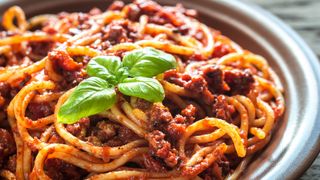
- 125g extra lean beef mince
- Small can of chopped tomatoes
- 1 small onion
- 6 mushrooms
- 1tsp oil
- Garlic, to taste
- Mixed herbs
- 75g wholewheat spaghetti (dry weight)
- 1tbsp grated parmesan
This meal provides 95% of your daily zinc needs and over 40% of the recommended selenium intake.
Snack: Small bowl of melon, pineapple and mango pieces. 1tbsp sunflower seeds. 130 calories
Week Three: Saturday
Breakfast: Omelette (350 calories)
- 2 eggs
- 1tsp reduced-fat spread
- 4 mushrooms
- 1 tomato
- 2tbsp reduced-fat cheddar
- 1 thick slice wholemeal toast
Lunch: Baked potato with baked beans (540 calories)
- Large baked potato
- Small can or pot of baked beans
- 1tbsp grated reduced-fat cheese
- Mixed salad (to serve)
- Orange (for dessert)
This hearty lunch staple provides more than half of your recommended fibre and iron intakes.
Dinner: Grilled tuna steak (540 calories)
- 1 tuna steak
- 200g roasted vegetables (courgette, onion, pepper, aubergine)
- 1tbsp oil
- ½ pack ready-to-eat quinoa
Tuna is high in selenium and this meal provides all of your recommended selenium intake. It also provides nearly 90% of your protein and over half of your iron needs.
Snack: Crispy kale (80g kale tossed in 1tsp oil and baked until crisp). 1 medium banana. 145 calories
Week Three: Sunday
Breakfast: Homemade parfait (355 calories)
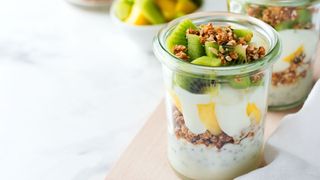
- 3 handfuls plain granola
- 2tbsp low-fat natural yogurt
- 80g fresh tropical fruit (pineapple, mango, kiwi fruit, orange)
- 1tbsp chopped mixed nuts (for topping)
Lunch: Vegetable and lentil soup (500 calories)
- 1 small onion
- 150g root vegetables (eg carrots, potato, sweet potato, parsnip swede)
- 2tsp oil
- 25g lentils
- 250ml reduced-salt vegetable stock
- Spices to taste
- 1tbsp low-fat yogurt (for topping, optional)
- 1 large wholemeal or seeded bap
Dinner: Sunday roast (490 calories)
- 100g roast chicken (skin removed)
- 175g boiled skin-on new potatoes
- 160g vegetables (eg cauliflower, carrots and steamed kale)
- 2tbsp gravy
- 80g strawberries (for dessert)
- 1 scoop ice cream (for dessert)
Snack: Toasted crumpet with fat spread from allowance. Apple. 175 calories
Week Four: Monday
Breakfast: Vegan overnight oats (355 calories)
- 40g oats
- 150ml plant-based drink (eg almond drink)
- 1tbsp chia seeds
- 80g raspberries (or frozen mixed berries)
- 1tbsp almond butter
Combine the ingredients in a bowl before you go to bed and leave overnight in the fridge to set.
Lunch: Chicken and avocado wrap (505 calories)
- 1 large wholemeal wrap
- 1 cooked chicken breast
- ½ avocado
- ½ pepper
Dinner: Tofu stir-fry with noodles (515 calories)
- 80g tofu, chopped
- 1 handful of cashew nuts
- 1 pak choi, sliced
- 1 spring onion, chopped
- 1tsp sesame oil
- 1tsp reduced-salt soy sauce
- 1tsp honey
- Ginger, to taste
- 1 nest of wholewheat noodles (60g dry weight)
Nuts are a great addition to meals because they contain healthier unsaturated fats. This meal provides over 40% of the recommended daily intake of monounsaturated fat, and it also delivers over 70% of your daily iron needs and almost half of the recommended intake of zinc.
Snacks: 1 chocolate digestive biscuit. 1 pear. 160 calories
Week Four: Tuesday
Breakfast: Scrambled egg, toast and grilled tomato (345 calories)
- 1 egg
- 1 thick slice of wholemeal toast
- 1tbsp sunflower seeds
- 1 tomato
Lunch: Tuna and bean pasta salad (525 calories)
- 75g wholewheat pasta (dry weight)
- Small can of tuna
- 2tbsp mixed or red kidney beans
- 1tbsp sweetcorn
- 1 slice of red pepper, diced
- 1tbsp oil (for dressing)
- Lemon juice, to taste (for dressing)
- Mustard, to taste (for dressing)
Enjoy this and you’ve ticked off half of your recommended fibre and iron intake and three-quarters of your daily selenium needs. We bet you didn’t know you even had selenium needs.
Dinner: Sautéed chicken and couscous (510 calories)
- 1 chicken breast
- 2tsp oil
- Garlic, to taste
- 6 mushrooms, sliced
- ½ pepper, sliced
- 1 small onion, chopped
- 60g couscous (dry weight)
- Lemon zest, to taste
- Chilli flakes, to taste
- Herbs, to taste
Sautée the chicken breast, mushrooms, pepper and onion, making sure the chicken is cooked all the way through. Flavour the couscous with the lemon zest, chilli flakes and herbs.
Snacks: 2 dried apricots and 5 almonds. 1 small pot of low-fat fruit yogurt. 195 calories
Week Four: Wednesday
Breakfast: Peanut butter and banana bagel (400 calories)
- 1tbsp peanut butter
- 1 wholemeal bagel
- 1 small banana, sliced
Lunch: Pitta with falafel (500 calories)
- 2 wholemeal pitta breads
- 4 falafels
- Shredded lettuce
- Grated carrot
- Drizzle of sweet chilli sauce
Dinner: Paella (490 calories)
- 60g paella rice
- 60g cooked chicken breast, chopped
- 60g prawns
- ½ pepper, diced
- 2tbsp frozen peas
- 1 small chopped tomato
- 200ml reduced-salt vegetable stock
- 2tsp oil
- Paprika, to taste
- Turmeric, to taste
Snacks: 1 slice of toasted seeded bread with yeast extract. 1 peach or nectarine. 200 calories
Week Four: Thursday
Breakfast: Cereal (335 calories)
- 2 shredded wheat
- 100ml reduced-fat milk or dairy alternative
- ½ nectarine
- Approx 10 raspberries
- 1tbsp sunflower seeds
Lunch: Ham or turkey salad sandwich (470 calories)
- 2 thick slices of seeded bread
- 1 slice of ham or turkey
- 1tsp mustard
- 1 tomato, sliced
- 1 handful of salad leaves
- Small bag (25g) of baked crisps
- Apple
Dinner: Vegetable chilli (525 calories)
- Small can of chopped tomatoes
- Small can of red kidney beans
- 1 small onion
- ½ pepper, diced
- 1 small courgette, diced
- Vegetable stock
- Garlic, to taste
- Chilli powder, to taste
- 1tsp oil, for frying
- 1 baked potato (to serve)
- 1tbsp 0% fat Greek yogurt (to serve)
You’ll get three-quarters of both your recommended fibre and iron intake from this mightily healthy meal.
Snacks: Handful of almonds (this snack provides over 40% of the recommended intake of monounsaturated fat). Carrot and cucumber sticks. 220 calories
Week Four: Friday
Breakfast: Poached egg and English muffin (350 calories)
- 1 wholemeal English muffin
- 50g wilted baby spinach
- 1 poached egg
- 2tsp sunflower seeds
- 150ml glass of apple juice
Lunch: Baked potato and beans (540 calories)
- 1 large baked potato
- Small can or pot of baked beans
- 1tbsp grated reduced-fat cheese
- Mixed salad (to serve)
- 1 orange (for dessert)
This classic lunch combo provides over half of your recommended fibre and iron intake.
Dinner: Chicken pesto pasta (570 calories)
- 1 grilled chicken breast
- 80g green beans
- 2tbsp peas
- 75g wholewheat pasta (dry weight)
- 1 heaped tbsp reduced-fat pesto
Snacks: 2tbsp low-fat plain yogurt with 80g mixed fresh fruit. 1tbsp ready-to-eat edamame (about 15 pods). 140 calories
Week Four: Saturday
Breakfast: Porridge (350 calories)
- 40g oats
- 300ml semi-skimmed milk
- 80g fresh or frozen berries (to serve)
- 1tsp flaxseeds
- 1tsp honey
Iodine and calcium are some of the stars of this meal, with more than 60% of your daily requirement of both in this breakfast bowl.
Lunch: Minestrone (520 calories)
- ½ carton chilled or canned shop-bought minestrone soup
- 1 ciabatta roll
- 1 apple
- 1 small cereal bar
Dinner: Homemade burger (490 calories)
- 125g extra lean minced beef
- 1 wholemeal bap
- Toppings: lettuce, tomato, onion
- 1tbsp ketchup
- Corn on the cob (to serve)
Opt for a homemade patty and wholemeal bun, and you’ll find this plate provides three-quarters of your daily protein needs and about half of the recommended fibre intake. Plus, you’ve covered off more than 80% of the recommended zinc intake and over half of your daily iron needs.
Snacks: 1 oatcake spread with 1tsp medium fat soft cheese with a few grapes. Crispy kale (80g kale tossed in 1tsp oil and baked until crisp). 155 calories
Week Four: Sunday
Breakfast: French toast (360 calories)
- 1 egg
- 2tbsp milk
- 1tsp oil
- 2 slices wholemeal bread
- 80g mixed berries (to serve)
Lunch: Baked vegetable frittata (480 calories)
- 2 large eggs
- ½ pepper, diced
- 1 small onion, chopped
- 1tbsp frozen peas
- A few cherry tomatoes, halved
- 1tsp oil
- 1tbsp grated reduced-fat cheddar
- Green salad (to serve)
- 1 medium wholemeal roll (to serve)
Dinner: Baked salmon with new potatoes (520 calories)
- 1 salmon fillet, baked
- 175g new potatoes, boiled
- 100g asparagus spears or tips
- 1 small slice (40g) banana loaf (for dessert)
Snacks: 1 orange. 1tbsp tzatziki and ½ wholemeal pitta bread. 160 calories

Jonathan Shannon has been the editor of the Coach website since 2016, developing a wide-ranging experience of health and fitness. Jonathan took up running while editing Coach and has run a sub-40min 10K and 1hr 28min half marathon. His next ambition is to complete a marathon. He’s an advocate of cycling to work and is Coach’s e-bike reviewer, and not just because he lives up a bit of a hill. He also reviews fitness trackers and other workout gear.
